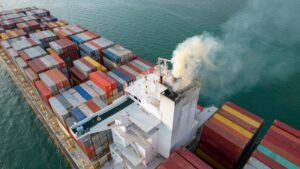GS3 – Environment

Context
Global maritime transport contributes to nearly 3% of global greenhouse gas (GHG) emissions. In response, efforts to decarbonise this sector are gaining momentum in line with international climate commitments.
The International Maritime Organisation (IMO) has set ambitious decarbonisation targets:
- 20% reduction by 2030
- 70% reduction by 2040
- Net-zero emissions by 2050
Decarbonisation involves strategies to significantly cut or eliminate carbon emissions from shipping activities.
Key Strategies for Decarbonising Global Shipping
- Transition to Alternative Fuels
- Adoption of low- or zero-emission fuels such as green ammonia, methanol, hydrogen, and biofuels.
- Growing use of electric and hybrid propulsion systems, especially in short-distance and coastal shipping, to phase out fossil-fuel-based engines.
- Technological Advancements
- Improved hull designs, wind-assisted propulsion, and advanced hull coatings to reduce drag and enhance fuel efficiency.
- Integration of solar panels, battery energy storage systems, and digital monitoring tools to optimise energy consumption and reduce emissions.
- Operational Efficiency
- Slow steaming (reducing ship speeds) helps lower fuel usage and emissions.
- AI-powered route optimisation and satellite navigation tools are being used to chart fuel-efficient and eco-friendly routes.
India’s Efforts in Maritime Decarbonisation
Target:
India is aiming for net-zero emissions in its maritime sector by 2070.
Major Initiatives:
- Harit Sagar Green Port Guidelines: Encourages sustainable port operations with a focus on clean energy use.
- National Green Hydrogen Mission: Promotes green hydrogen as an alternative maritime fuel.
- Green Tug Transition Programme: Plans to switch harbour tugboats to environmentally friendly fuels.
- Coastal Shipping Bill, 2024: Aims to promote low-emission transport modes and reduce overall logistics costs.
Challenges in Global Shipping Decarbonisation
- High Costs: Alternative fuels like green ammonia and hydrogen remain expensive and scarce.
- Inadequate Infrastructure: Most ports lack facilities for alternative fuel bunkering and electrified docking.
- Technological Limitations: Green propulsion systems are still in development stages and not yet commercially scalable.
- Regulatory Fragmentation: Absence of uniform global standards impedes consistent implementation.
- Industry Resistance: Concerns about higher operational costs and commercial viability deter widespread adoption.
Way Forward
- Global Standards: Enforce uniform emission regulations to drive international compliance.
- Port Infrastructure: Upgrade ports to support clean fuel supply and electrification.
- Incentivise Innovation: Offer financial incentives such as tax breaks, carbon credits, and subsidies for adopting green technologies.
- Public-Private Collaboration: Promote PPP models to leverage private sector investment and innovation.
- Green Shipping Corridors: Establish emission-free trade routes through multilateral partnerships.




